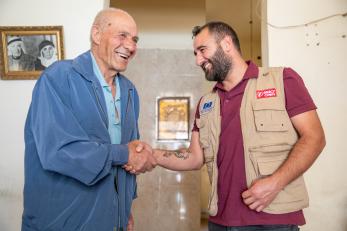Community consultations for the design of multipurpose cash assistance programs in Lebanon

Since late 2019, Lebanon has been grappling with a severe economic and financial crisis. The Lebanese lira has lost more than 98 percent of its value, and over half of the Lebanese population is estimated to be living in poverty. The Government of Lebanon and development and humanitarian agencies have scaled up their cash response and increased the reach of social safety nets to alleviate suffering. Humanitarian agencies have also stepped in to assist those who fall through the cracks of the government safety nets with multi-purpose cash assistance.
Mercy Corps’ SAFER programme assists poor Lebanese families with an integrated Cash-Plus package of assistance. In October 2023, Mercy Corps Lebanon conducted a series of consultations with Lebanese communities in the Bekaa Valley with the dual objective of increasing the participation of Lebanese communities in the design of multi-purpose cash assistance programmes and identifying ways in which SAFER can complement social safety nets.
Key findings
- Unlike the Syrian refugee crisis, Lebanese communities receiving or in need of assistance have not been displaced. Instead, they have been forced to contend with the effects of Lebanon’s economic and financial crisis, cutting across traditional humanitarian categories. Some of the distinctive features of the Lebanese poverty crisis are inadequate social insurance, inconsistent remittances, and dilapidated social protection mechanisms.
- Social safety net targeting systems are outdated and inadequate to identify segments of the population that have recently fallen into poverty due to the crisis. Lebanese families find it difficult to benefit (whether by sale or other method) from the durable good or assets which they currently have. Selling those assets is not considered a viable option either, primarily due to low demand for those goods.
- Use of the PMT algorithm dictates that selection variables are weighted against each other, making the outcomes of the selection process difficult to predict. The targeting system for the social safety net is perceived as opaque; limited understanding of how poverty-targeting mechanisms work can foster mistrust in the way social assistance is distributed.
- Humanitarian or social assistance recipients often feel stigmatised by their peers, which can lead to negative behaviours. Community members may seek to misrepresent their living conditions while trying to maintain a facade of normality. Therefore, seeking assistance is the coping strategy of last resort, which affected families tend to avoid or postpone.
- Some community members expressed a preference for forms of livelihood assistance that can generate a sustained impact, including support to small and medium enterprises and small cash grants to start businesses. The preference for livelihood interventions was common particularly among male participants.
- In the changing context of the Lebanese crisis, social assistance systems need to incorporate adaptive solutions to register programme participants on a rolling basis, while also providing support to those who struggle with the registration process. Given their agile structure and small scale, NGOs can offer a shock-responsive solution to alleviate poverty through multi-purpose cash assistance, until social safety nets’ registration reopens.
- Community members want to be involved in the design of cash assistance programmes, particularly in the outreach, registration, and selection phases.
- The programme should inform rejected applicants about why they were not selected and be easily understood by affected applicants.
- The majority of participants expressed a preference to receive multi-purpose cash assistance through OMT over other financial service providers. The reasons mentioned include OMT’s high number of outlets, historical presence, and reputation.
- The low amount of small denomination USD banknotes in circulation, commissions, and overcrowding are some of the challenges related to using financial service providers.
Recommendations
Based on the findings of the community consultations, the following recommendations tackle how Mercy Corps can strengthen the next phase of the SAFER programme.
- Enhance community participation in the implementation of the next SAFER multi-purpose cash programme, for example, by establishing community committees.
- Close the feedback loop with communities. Mercy Corps should consider ways to share the results of the consultation, recommendations, and their responses with targeted communities.
- Adopt a wide array of outreach and registration channels, such as open desks in community centres, phone lines, and digital forms. Schools, churches, and mosques could also assist in identifying poor families and ensure that no vulnerable member of the community is left behind.
- Adopt a targeting approach that is easily understood by communities. The humanitarian imperative of assisting the most vulnerable needs to be balanced with the do-no-harm principle and considerations around avoiding unintentional tensions in the community.
- Assess the presence, capacity, and preference of community members regarding FSPs in communities selected for the next SAFER project. Evaluation criteria should go beyond efficiency considerations and include the capacity, presence, and preferences of community members.
- Time the upload of assistance so that it does not overlap with large-scale cash programmes.